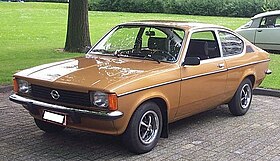Opel Kadett C
| Kadett C | |
|---|---|

1978 Opel Kadett C Coupe 1.2S.jpg
|
|
| Overview | |
| Manufacturer | Opel (General Motors) |
| Also called |
Buick Opel (USA) Chevrolet Chevette (BRA) Daewoo Maepsy (ROK) Holden Gemini (AUS) Isuzu Gemini (J) Saehan Gemini/Bird/Maepsy (ROK) Opel K-180 (ARG) Vauxhall Chevette (UK) |
| Production | 1973–1979 |
| Assembly |
Bochum, Germany Antwerp, Belgium |
| Body and chassis | |
| Class | Small family car (C) |
| Body style |
"Limousine" (2/4-door Saloon/Sedan) "City" 3-door hatchback "Caravan" (3-door estate / Kombi / stn wgn) Coupé "Aero" (targa-top cabriolet) |
| Powertrain | |
| Engine | |
| Transmission | 4-speed manual 5-speed "dog leg" manual (GT/E) 3-speed automatic |
| Dimensions | |
| Wheelbase | 2,395 mm (94.3 in) |
| Length | 4,127 mm (162.5 in) 3,922 mm (154.4 in) (City) 4,140 mm (163 in) (Caravan) |
| Width | 1,580 mm (62 in)) |
| Height | 1,375 mm (54.1 in) 1,340 mm (53 in) (Coupé) 1,385 mm (54.5 in) (Caravan) |
| Curb weight | 790 kg (1,741.7 pounds) (Coupé) |
| Chronology | |
| Predecessor | Opel Kadett B |
| Successor | Opel Kadett D |
The Opel Kadett C is a small family car which was produced by the German automobile manufacturer Opel from 1973 to 1979. The Kadett C, which was the third generation of the Opel Kadett, was released in August 1973, and was Opel's version of the General Motors' "T-Car". It was the last small Opel to feature rear-wheel drive, and remained in production at Opel's Bochum plant until July 1979, by which time Opel had produced 1,701,076. Of these, 52% had been exported outside West Germany, most of them to markets in other parts of western Europe. In other world markets however, various badge engineered versions of the Kadett C remained in production as late as the mid 1990s under other GM brand names.
The body of the Kadett C was seen as being less lumpy and better proportioned than that of the Kadett B. In terms of overall dimensions, however, the two were actually very similar.
Most customers opted for the "Limousine" bodied saloon/sedan car which came with two doors. A four-door "Limousine" was produced mostly for export to markets where cars of this size with only two doors encountered customer resistance. In West Germany itself, however, the small family car market continued to be dominated and defined by Volkswagen for whom two doors in a small family car was still quite sufficient: the four door Kadett C is remembered in Germany as an "export special". The Limousine body accounted for just under 63% of the Opel Kadett Cs produced. A further 11% were three door estate-bodied cars badged, following Opel tradition, as the Kadett Caravan, with the two-door coupés accounting for slightly under 10%. Publicity of the time, possibly originating with Mercedes-Benz, indicated that in order to minimize the risk of fire in the event of collision, the safest position for a car's fuel tank was above the rear axle between the passenger cabin and the boot/trunk, and this is where the Kadett C "Limousine" and "Coupé" had their fuel tanks fitted, accessible for replenishment via the (unexpectedly, hinged,) extractor vent on the car's right-side C-pillar. On the "Caravan" bodied estate car the fuel tank was a flatter shape, and was positioned under the rear cargo area.
At the end of May 1975 the "Kadett City" was added to the range. This was a three door hatchback intended to compete on price (though not on space efficiency) with the Ford Fiesta, launched in Germany in the same month. The concept had first originated on the Kadett C's Vauxhall sister car the Chevette which was launched first. The unique panelwork for the Kadett City was in fact produced at Vauxhall's Ellesmere Port plant and exported to Bochum for assembly into finished bodyshells. The Kadett City sat on the same wheelbase as the other Kadett Cs, but the rear overhang was shortened. The fuel tank was positioned under the floor of the luggage compartment at the back, as on the Caravan bodied cars, but the fuel tank on the "Kadett City" had a capacity of only 37 litres as against 43 litres for the slightly longer "Kadett Caravan". Both models featured rear seats that could be folded forward to give a long and relatively unimpeded load area. 263,090 "Kadett City" bodied cars were produced, representing more than 15% of the Kadett Cs produced by Opel, Germany.
...
Wikipedia
